

Lots of Wearables, But Nothing Worth Wearing Yet. If you thought Google Glass was an affront to fashion, wait until you get a load of the copycats at Tokyo's first Wearable Expo.
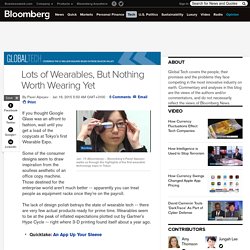
Some of the consumer designs seem to draw inspiration from the soulless aesthetic of an office copy machine. Those destined for the enterprise world aren't much better -- apparently you can treat people as equipment racks once they're on the payroll. The lack of design polish betrays the state of wearable tech -- there are very few actual products ready for prime time. Wearables seem to be at the peak of inflated expectations plotted out by Gartner's Hype Cycle -- right where 3-D printing found itself about a year ago. Next Future Wearable Technology Will Blow Your Mind.
A Strong Sense for Natural Interactions. Hrvoje Benko This week, Microsoft researcher Hrvoje Benko (@hrvojebenko) is in Hawaii, but not on one of the islands’ beautiful beaches.
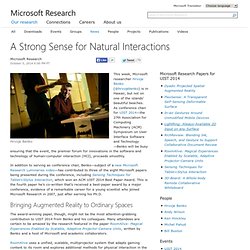
As conference chair for UIST 2014—the 27th Association for Computing Machinery (ACM) Symposium on User Interface Software and Technology—Benko will be busy ensuring that the event, the premier forum for innovations in the software and technology of human-computer interaction (HCI), proceeds smoothly. In addition to serving as conference chair, Benko—subject of a new Microsoft Research Luminaries video—has contributed to three of the eight Microsoft papers being presented during the conference, including Sensing Techniques for Tablet+Stylus Interaction, which won an ACM UIST 2014 Best Paper Award. This is the fourth paper he’s co-written that’s received a best-paper award by a major conference, evidence of a remarkable career for a young scientist who joined Microsoft Research in 2007, just after earning his Ph.D.
Flying High at Microsoft Research. RoomAlive: Magical Experiences Enabled by Scalable, Adaptive Projector-Camera Units. Meta Space Glasses - Better Than Google Glass? Control Your Virtual World. Milionový nápad. Displej bude promítaný na zápěstí. Creating Augmented Reality for Education. The cARe project explores two examples of how Augmented Reality (AR) could be used to enhance learning.
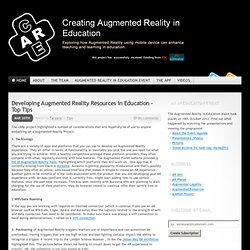
The examples focus on the use of AR with nursing students. Further details of the projects are described below. You can also watch the video that was used to describe the project. Example 1 – Clinical Skills Laboratory The first of these projects looked at the use of AR in supporting simulated practice. The Augmented Web: Simplifying Augmented Reality In Education. The Augmented Web: Simplifying Augmented Reality In Education by Maria Politis, Head of Content and Community at buildAR If you spend time on twitter looking at the #augmentedreality and #edutech hashtags you will know that there is quite a lot of discussion going on about Augmented Reality, and how it can be used as an educational tool.
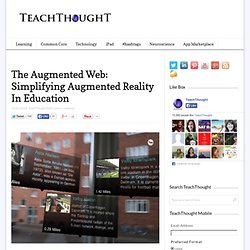
And with good reason. The web is full of innovative examples of how Augmented Reality is used in classrooms around the world every day. The ability to overlay digital content and information onto the real world, using triggers like images and locations opens up a world of rich learning opportunities. There is a wide range of Augmented Reality applications for the classroom currently available and real, practical uses of the technology are easy to find. Meta (@metaglasses) Oculus Rift - Virtual Reality Headset for 3D Gaming. See it, touch it, feel it: Researchers use ultrasound to make invisible 3-D haptic shape that can be seen and felt. Technology has changed rapidly over the last few years with touch feedback, known as haptics, being used in entertainment, rehabilitation and even surgical training.

New research, using ultrasound, has developed an invisible 3D haptic shape that can be seen and felt. The research paper, published in the current issue of ACM Transactions on Graphics and which will be presented at this week's SIGGRAPH Asia 2014 conference [3-6 December], demonstrates how a method has been created to produce 3D shapes that can be felt in mid-air. The research, led by Dr Ben Long and colleagues Professor Sriram Subramanian, Sue Ann Seah and Tom Carter from the University of Bristol's Department of Computer Science, could change the way 3D shapes are used. The new technology could enable surgeons to explore a CT scan by enabling them to feel a disease, such as a tumour, using haptic feedback. The method uses ultrasound, which is focussed onto hands above the device and that can be felt. Sit Back, Relax, and Enjoy This Patent-Pending Virtual Reality Helmet. Image: US Patent and Trademark Office We like to romanticize commercial air travel.
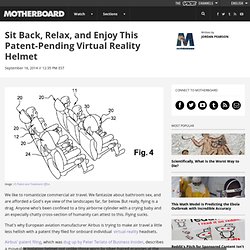
We fantasize about bathroom sex, and are afforded a God's eye view of the landscapes far, far below. Home: Meta Company. Google Glass. See it, touch it, feel it: Team develops invisible 3-D haptic shape (w/ Video) Technology has changed rapidly over the last few years with touch feedback, known as haptics, being used in entertainment, rehabilitation and even surgical training.

New research, using ultrasound, has developed an invisible 3-D haptic shape that can be seen and felt. The research paper, published in the current issue of ACM Transactions on Graphics and which will be presented at this week's SIGGRAPH Asia 2014 conference [3-6 December], demonstrates how a method has been created to produce 3D shapes that can be felt in mid-air. The research, led by Dr Ben Long and colleagues Professor Sriram Subramanian, Sue Ann Seah and Tom Carter from the University of Bristol's Department of Computer Science, could change the way 3D shapes are used. The new technology could enable surgeons to explore a CT scan by enabling them to feel a disease, such as a tumour, using haptic feedback.
The method uses ultrasound, which is focussed onto hands above the device and that can be felt. The Structure Sensor is the first 3D sensor for mobile devices. Google Glass. Oculus Rift. Optinvent. Pivothead video glasses offer impressive quality, we go hands-on (sample video) PROJECTS. Sunao Hashimoto, Akihiko Ishida, Masahiko Inami, Takeo Igarashi Abstract The most popular remote control method for robot is a joystick and a gamepad.

However, these methods are difficult for inexperienced users because the mapping between the user input and resulting robot motion is not always intuitive. To solve this problem, we propose a augmented reality based interface for remotely controlling a robot from a third-person view, which is called “TouchMe”. TouchMe: An Augmented Reality Based Remote Robot Manipulation.
The Sword of Damocles (virtual reality)